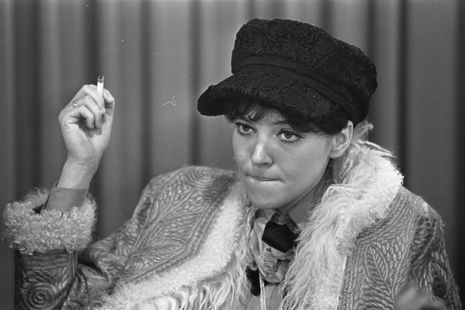The Worst Person in the World and Vivre sa Vie: women divided into twelve
In her latest instalment of ‘Dream Double Features’, Abby Reeves discusses two films that centre their female protagonists

When we first meet Julie in The Worst Person in the World, she is a fresh-faced medicine student with mousy brown hair swept into a ponytail, studious and plain. Across the film’s 12 chapters (plus prologue and epilogue), this image becomes increasingly unstable. She chops and dyes her hair as quickly as she switches subjects and dives into the working world as a photographer. In some scenes, she can pass as a Dakota Johnson look-alike. In others, she resembles a Scandinavian it-girl decked in minimalist, neutral-toned clothes. Julie is a chameleon-like protagonist, the antithesis of Godard’s hybrid muse-lover Anna Karina in Vivre Sa Vie. Karina plays Nana, sporting an iconic black bob and dark eyeliner which complements her doe-eyed gaze. This look is consistent throughout the film as we witness Nana’s descent into the world of sex work.
“The number 12 is associated with astrology and cosmic order”
Both films fixate on their female protagonists and, despite being directed by men, provide relatively nuanced portrayals of these characters. When we first meet Nana, she is sitting in a café with her back towards us as a disembodied male voice monologues at her. We glimpse her blurry reflection in a mirror and, eventually, the camera pivots to show her face-on. This technique of detaching male voices from their source continues throughout the film, ensuring that we focus on Nana rather than the men speaking around (or, more appropriately, at her). Similarly, we see men pass in and out of Julie’s life, one boyfriend traded for another. We sigh in relief as the first – Aksel, 15 years Nana’s senior and toeing the line of political correctness – is traded for another – the charming, eco-conscious Eivind who has a secret mushroom supply. Neither ultimately lasts and Julie drifts through the depths of her late 20s untethered and alone.
Nana and Julie both experience life in free-fall: Nana spirals towards sex work as Julie drifts somewhat at sea through adulthood. The order our female protagonists seek in their chaotic lives is instead provided meta-cinematically through a 12-chapter structure. The number 12 is associated with astrology and cosmic order, creating a divine framework akin to Julia Kristeva’s conception of “women’s time” – an idea centred on women asserting themselves in a space and time that rejects masculine linearity.
“Godard’s dozen chapters unravel in the new-wave style of strict realism”
Godard’s dozen chapters unravel in the new-wave style of strict realism, disrupted only by intentionally choppy editing such as the montage of Nana’s working life. Here, there are jump cuts between doors opening and closing, money changing hands and dresses nearly unbuttoned. Conversely, Joachim Trier’s contemporary film allows Julie to have the occasional surrealist romp. She gets a break from the temporal fabric of reality while racing through Oslo, the world frozen around her in comic tableaus of the minutiae of life. Later, her subconscious fears and desires reign supreme in a dream-like sequence, unleashed by Eivind’s aforementioned mushroom stash.
Throughout these chapters, we become deeply familiar with each woman’s inner and outer worlds. However, this sense of intimacy is not left intact. Both directors encase their protagonists within the fictional fabric of cinema and highlight our position as spectators.
In the most iconic scene of Vivre sa Vie, Nana watches the critically acclaimed silent film The Passion of Joan of Arc (1928). Godard cuts between both women’s upturned faces in extreme close-up. Joan has been told she will burn on the cross. She turns her face to the heavens, tears in her eyes, looking to God for the divine intervention she so devoutly believes in. Nana, also crying, gazes up at her own personal deity: the cinema screen. And we, the audience, participate in this chain of seeing (and, depending on your sensibilities, weeping) as we are moved by the events on screen – events which we are simultaneously independent from and deeply entwined in.
At the end of The Worst Person In the World, we leave Julie as a successful photographer and single woman. She observes her ex-boyfriend and his new model (literally and figuratively) wife and child during a moment that threatens to morph into a metaphorical end of the world. Life can feel like it’s ending when the heteronormative dream denied to you plays out perfectly for others. However, there is a sense of bittersweet harmony as the credits roll and ‘Waters of March’ fills your ears. In the words of Art Garfunkel, it’s “the end of the road” for our time with Julie who is finally left “a little alone”, her theoretical life sprawling in front of her, bereft of an audience to witness it.
Total length: 212 minutes/3.5 hours. Begin with Godard in black and white before enjoying Trier’s more lively romp around Oslo.
Recommended if you like: Being aimless and hot in your 20s, films centring women and an approachable introduction to Godard.
 News / Eight Cambridge researchers awarded €17m in ERC research grants27 December 2025
News / Eight Cambridge researchers awarded €17m in ERC research grants27 December 2025 News / Clare Hall spent over £500k opposing busway 24 December 2025
News / Clare Hall spent over £500k opposing busway 24 December 2025 Comment / League tables do more harm than good26 December 2025
Comment / League tables do more harm than good26 December 2025 Comment / The ‘class’ of Cambridge24 December 2025
Comment / The ‘class’ of Cambridge24 December 2025 News / Caius mourns its tree-mendous loss23 December 2025
News / Caius mourns its tree-mendous loss23 December 2025









